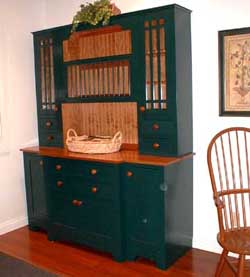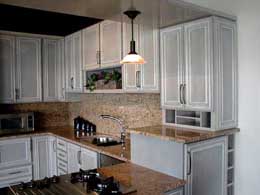Painting Kitchen Cabinets
DEAR TIM: I would like to have a fresh look in my kitchen. However, my scrooge husband has indicated that we can only spend $1,000. Do you think I can get superior performance from painting my existing cabinetry? If so, what type of paint will deliver top performance? Are there any pitfalls to avoid while attempting this job? What other things can I do to breathe new life into my dull kitchen? I am very handy and will do the work myself. B.E.
 DEAR B. E.: Painting your existing cabinets is a wonderful alternative to purchasing new cabinetry. What's more, this will give us nearly $950 to spend on other goodies. I firmly believe that you will be delighted with the results.
DEAR B. E.: Painting your existing cabinets is a wonderful alternative to purchasing new cabinetry. What's more, this will give us nearly $950 to spend on other goodies. I firmly believe that you will be delighted with the results.
You have three main options with respect to the final paint finish that you can apply to your cabinets. As you might imagine, all have their advantages and disadvantages. Your primary concern should be the hardness of the final finish. Kitchen cabinets require a hard finish that will resist scratches and chips.

The hardest paint that is available to most homeowners is an epoxy modified alkyd paint. These are most commonly found in aerosol spray cans. After these paints cure, they typically have a harder finish than you could obtain with an oil or water based paint that is brushed on. Spraying paint is an art. Sags and runs are possible if you are not careful. Areas adjacent to the cabinets must be meticulously protected from paint overspray. Fumes can be a problem as well.
Alkyd or oil based paints will produce exceptional high gloss finishes and rapid cure times. This is important if you need to get your kitchen up and running again. Many oil based paints will dry to a superior hardness within 48 hours. This allow you to cook and move about without fear of damaging the new finish. However, alkyd/oil paints often produce strong fumes while drying. They require the use of mineral spirits or thinner to clean your tools.
Acrylic water based paints offer acceptable hardness, low odor, and ease of clean up. However, acrylic paints tend not to be as glossy as oil based paints. In addition, it takes considerably longer for acrylic finishes to reach acceptable hardness levels. You may have to wait 5 - 7 days before the finish with withstand significant abuse. Furthermore, you must use an oil based primer over your previously painted or urethaned cabinetry. The oil primers tend to grip the old surface much better than water based primers.

Wash the surfaces to be painted with a strong solution of soap and water. Don't be afraid to scrub. After the cabinets dry, remove all doors and empty the drawers. We will paint these in the basement or garage. Remove all hinges, knobs, and other hardware. Sand all surfaces that will receive new paint. Eliminate all sources of dust. Apply the primer with a small roller to speed application. Immediately brush the paint to give it a smoother finished look. Allow the primer to dry for one day. Apply the finish coat as soon as possible using the roller and brush method. Do not reassemble the cabinets until the paint finish has hardened.
The remainder of your cash can be spent on new countertops, a faucet, and possibly some affordable wallpaper. If you do some smart shopping, you will have money left over to buy that delightful sweater you saw in the mail order catalog.
Author's Note: If you want to save thousands of dollars, you should read my Painting Cabinetry eBook. It has step-by-step photos and instructions that show you how to paint cabinets. I guarantee that you will be satisfied.
Read Carolyn's email about painting cabinets and Tim's advise in the January 4, 2009 AsktheBuilder Newsletter.